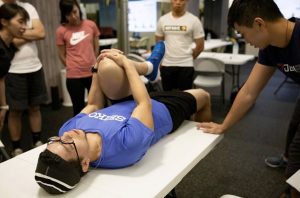Long gone were the days whereby personal training is only about providing exercise information, bringing a client through an exercise sessions and demonstrating exercise techniques. In fact, you can now get that from the internet and it is more a job of a gym instructor. So, let us find out why personal training is so expensive!
A personalized approach to programming means you respect the unique background of each client thus you are capable of helping your client to discover their unique potential and pathway towards their goal.
In short, we are a process coach. To be able to do that, we need the following skills and knowledge:-
1. Rapport
One of the greatest characteristics of a successful personal trainer is rapport building.
Personal trainers need to consistently show warmth, genuineness and empathy towards their clients and always provide non-judgmental and corrective feedback. A good personal trainer believes in empowering clients to become successful exercisers by decreasing dependency towards the trainer.
 2. Discovering Goal, Readiness and Motivation
2. Discovering Goal, Readiness and Motivation
Nothing is more important than knowing what your client needs, wants and their underlying motivation. Well, sometimes what they want is not what they need now or vice-versa. Also, sometimes what clients want is not what we can help. In addition to that, we need to find out if our clients are serious to their goal and their commitment level.
3. Client Assessments
a. Health & Physical Fitness
It is crucial to find out our clients’ current health status to ensure no exercise contraindications as well as potential health risk are made. To develop a programme that is personalized, also requires us to know their fitness level. This includes their cardiovascular, strength, endurance, movement mechanics, mobility, balance, posture and joint stability.
b. Preferences and Lifestyle Barriers
In order to encourage programme sustainability, we need to choose exercises that are deemed fun to them, safe and effective towards their goal. Personal trainers need to understand their client’s lifestyle barriers (work, stress, travels,etc) which may influence programme adherence and help clients to discover how they can balance exercise with lifestyle barriers.
4. Personal Programming
The first step towards exercise programming is to have a good understanding on exercise science. We need to understand how our cardiovascular, energy, skeletal and muscular system works. It helps us to comprehend the purpose of our exercise recommendations and provides us with the skills to troubleshoot personal training implementation issues.
b. Training guidelines
Learn internationally accepted exercise training guidelines that are safe andeffective. This includes nutrition, cardiovascular, resistance and flexibility.
c. Programming
We should be able to integrate our exercise science knowledge, client assessment results and training guidelines thus proposing to our clients their unique pathway towards their goal. This safe, effective and enjoyable plan should be an agreed and shared plan between you and your client.
5. Programme Implementation
a. Exercise techniques
Discover latest accepted exercise techniques and the skill to progress or regress the exercise to meet client needs & ability. This includes spotting and instructional methods.
b. Modification
Programme needs to be modified throughout the journey. It might need to be progressed, regressed, substituted or changed due improvements, inactivity, injuries, boredom, new preference and lifestyle barriers.
 Therefore a personal trainer’s role today is shifting from a technician towards a process coach. They are capable to help clients achieve their goals by choosing a personalized pathway towards their goal.
Therefore a personal trainer’s role today is shifting from a technician towards a process coach. They are capable to help clients achieve their goals by choosing a personalized pathway towards their goal.





